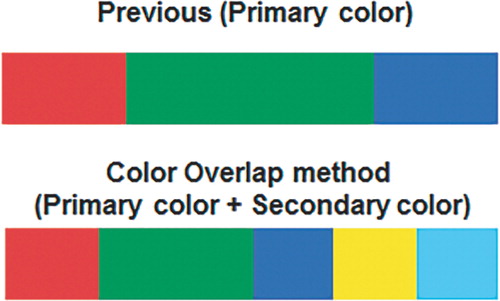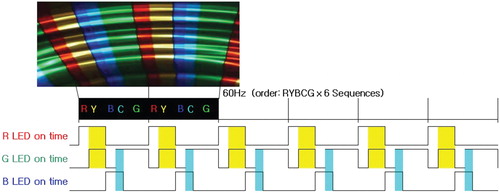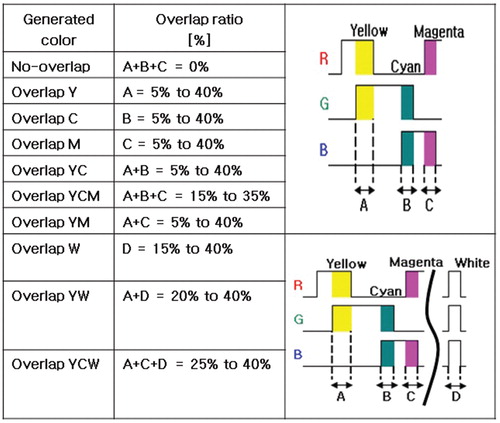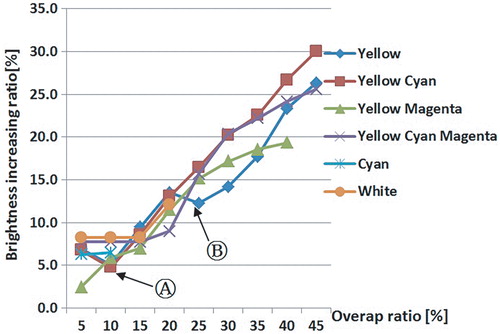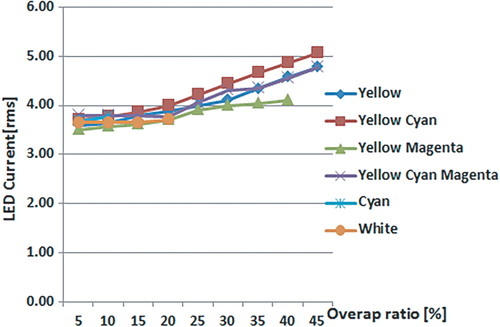Abstract
A synthesis of red, green, and blue light-emitting diodes (LEDs) for increasing the brightness of projectors using a digital micro-mirror device (DMD) panel is proposed. This color synthesis method drives the current-pulse-width-modulated signals of red, green, and blue LEDs. The proposed method synthesizes the yellow and cyan colors from the red, green, and blue primary colors with the LEDs’ overlapping ratio. Through the proposed method, the brightness of the projector is increased by around 33.3% compared to the non-color-overlapping condition in a DMD projector with LEDs.
1. Introduction
The solid-state device as a light-emitting diode (LED) should be designed as a relationship between the optical-output power and the heat-dissipative structure to reduce the junction temperature of LED, and LED is designed to operate with forward current driving under both the continuous waveform driving method and the pulse width modulation (PWM) driving method [Citation1].
shows the brightness and efficiency characteristics of the typical LEDs. It is noted that the brightness is not proportional to the current and that the efficiency decreases as the current increases. The junction temperature of LED is highly sensitive to the ambient temperature and forward current, which are controlled by the PWM driving mode. The lifetime and optical power are affected by the junction temperature of LED. On the other hand, if the input forward current is low, the output optical power will be lower. Eventually, LED cannot be applied as the light source of the DMD projector due to the former's lower optical-output power. Therefore, the optical efficiency, driving method, and forward current are very important [Citation2, Citation3].
In this paper, the design of a new LED driving method for increasing the brightness of DMD projectors is proposed [Citation4–6]. Whereas the traditional driving methods use the red (R), green (G), and blue (B) colors, the proposed driving method uses the R, G, B, yellow (Y), and cyan (C) colors, as shown in . The driving efficiency of the LEDs is improved by increasing the duty ratio of the secondary colors (Y, C, and magenta (M)).
DMD consists of an array of digital light switches that accept electrical words as their inputs and that output optical words. It is the necessary functionality for taking a digital source and projecting its image onto a projection screen. The functionality includes image processing, memory, timing control, a light source, and projection optics. Digital light processing (DLP) provides an all-digital projection display solution, accepting a digital electrical input and outputting a digital optical image. It is the equivalent of the electrical switch or gate in memory or microprocessor technologies. The DMD light switch involves not only the electrical domain but also the mechanical and optical domains. Responding to an electrical input signal, the DMD light switch uses electromechanical action to interact with incident light and to switch that light into time-modulated light bundles at its output [Citation7, Citation8].
This paper is organized as follows. In Section 2, the proposed method is described. The experiment results and the conclusions are given in Sections 3 and 4, respectively.
2. Proposed system
The color overlapping method is proposed for providing more efficient and higher-brightness LED illumination compared to the conventional method, in which the colors do not overlap. The driving efficiency of the LEDs is improved by increasing the duty ratio of the secondary colors (e.g. Y and C) obtained from the color synthesis between the primary colors (R, G, and B).
In , the driving pulse wave of the LEDs (R, G, and B) is shown. Y is produced from R and G via synthesis, and C is produced from G and B also via synthesis. Each frame is composed of a sequence of several colors, and the color sequence consists of primary and secondary colors. For instance, when one frame (duration: 1/60 Hz = 16.67 ms) is composed of six sequences of five colors, as shown in , the available timeslot for each sequence is 2.78 ms. The percentage of this 2.78 ms timeslot consisting of a secondary color is called the “overlap duty ratio.”
Several possible examples of the proposed color overlapping are shown in . The brightness (in ANSI lumens) of the DMD projector with an increasing duty ratio of the generated secondary colors (Y, C, and M) for the frames at a frequency of 60 Hz was measured, and the optimal combination was found, as described in Section 3. It is noted that due to the limits of the frame frequency, the duty ratio of the primary color decreases as the duty ratio of the secondary color generated from primary color synthesis increases. This may cause bad color linearity. Therefore, the secondary color ratio is a very important factor in image quality [Citation5–6].
3. Experiment results
To find the optimal combination of overlapping primary colors among all the combinations, the experiment results of brightness measurements (in ANSI lumens) for several cases are shown: Y; C; M; Y and C; Y and M; Y, C, and M; white (W); etc. It is noted that the experiments for all the combinations showed that one of these cases yielded the best result of all the combinations.
shows the results of the white brightness (ANSI lumens). It is shown that the proposed color overlapping method increases the white brightness to a large extent. It is also shown that the brightness increases with the color overlap duty ratio. For the color overlap duty ratio up to 45%, the brightness of the projector increase ranges up to 30%. When the color overlap duty is fixed, the maximum increase in brightness among all the possible color overlapping combinations is obtained from the YC overlap. The overlap duty ratio is one of several factors that affect the brightness (in ANSI lumens) of the DMD projector. The junction temperature of LED and the green duty ratio of the color sequence are also important factors. If the green duty ratio is not enough, the white brightness (ANSI lumens) of the projector decreases, as shown in parts A and B in .
The advantage of the LED projector is that it has a wide color gamut compared to the conventional light sources, such as a mercury-arc lamp. In this paper, a method of increasing the white brightness (in ANSI lumens) of the DMD projector is proposed: synthesizing the white (W) color using the Y, C, and M colors with the R, G, and B colors generated by the LED overlapping method. The color gamut of the overlapping method is wider than the Rec. 709 (ITU-T recommendation of the display standard color space) color coordinates. This paper evaluates the color quality of the overlapping method, as shown in . It proves that there is no significant difference in color quality between the overlapping and non-overlapping methods.
shows the total power consumption of each of the color overlapping methods. As shown, the YC overlap demands the highest current. Compared to the increasing rate of brightness, however, the current increasing rate of YC overlapping is known to be limited. Hence, it is concluded that YC overlap is the most efficient way to increase the brightness among all the color overlapping combinations.
shows the results of the use of the non-overlapping method and the overlapping method, the high-current PWM driving method for increasing the brightness of a projector. In this study, a comparative analysis of W brightness (ANSI lumens) measurement experiments was done according to two LED driving methods with the same power consumption. As shown, the W brightness of the projector was 243 lm under the condition of 138.9% LED overlapping at the current PWM mode. As a result, the brightness of the projector using the R, G, B, Y, and C color sequence was improved by about 33.3% compared to when the LED non-overlapping method was used.
Table 1. Non-overlapping driving and overlapping driving modes.
Besides, the junction temperature of the R, G, and B LEDs is an important factor in projectors. The experiment results on the LED overlapping method and forward current capacity showed a high correlation between the optical power efficiency of LED and the junction temperature of LED. It was also shown that the proposed method has better LED brightness and optical efficiency than the conventional methods, such as the continuous current mode.
It is noted that the optical-output power of LED is not proportional to the current, and that the efficiency decreases as the current increases. As such, it is very important to find the optimal driving condition for LED to be used as the light source of a projector.
4. Conclusion
This paper proposes a driving method for increasing the optical efficiency and decreasing the junction temperature of light-emitting diodes (LEDs). This method creates a high-brightness LED projector that uses secondary colors. It has been shown that the secondary colors (yellow [Y], cyan [C], and magenta [M]) may increase the optical efficiency of LEDs in a DMD projector that is compact and has low power consumption, which demonstrates the merits of this projector design. This method improves the brightness by 33.3% when the color overlap is composed of the red (R), Y, green (G), C, and blue (B) sequential colors. This color overlapping method decreases the junction temperature and increases the optical efficiency and lifetime of LEDs as the light source of the DMD projector.
Disclosure statement
No potential conflict of interest was reported by the author.
Additional information
Yongseok Chi received his M.S. and Ph.D. degrees in electronics and electrical engineering from Dankook University in 2008 and 2014, respectively. From 1998 to 2000, he was a research engineer at Elevator Research Lab. in LG Industrial Company. From 2000 to 2004, he was a research engineer at PDP Research Lab. in Samsung SDI Co., Ltd., and from 2000 to 2012, he was a chief research engineer at Materials and Devices Research Lab. in LG Electronics. He is currently an assistant professor at Dongseo University in South Korea. His research interests are display and optical systems.
References
- T. Nonaka, M. Matsuda and T. Hase, in: Proceedings of IEEE Tenth International Symposium on Consumer Electronics, 2006.
- K. Kurahashi, J. Inst. Telev. Eng. Jpn., 40 (5), 392–397 (1986).
- W. Kunzman and G. Pettitt, White enhancement for color sequential DLP, in: Proceedings of the Society for Information Display Conference, 1998.
- L.A. Yoder, Introduction to digital micromirror device (DMD) technology, Texas Instrument Application Report, DLPA008, 2008.
- L.J. Hornbeck, Digital Light Processing (DLP) für ein Display mit Mikrospiegel-Ablenkung, Germany, 1996.
- G.S. Pettitt, A. DeLong and A. Harriman, Optical and colorimetric performance analysis for a sequential-color DLPTM projection system, in: Society for Information Display International Symposium Digest of Technical Paper, 27, 1996.
- Texas Instruments, DDP ASIC Front End Component Set, Production manual, 13–68 (2011).
- L.J. Hornbeck, Digital Light Processing and MEMS: Timely Convergence for a Bright Future, 2–14 (1988).


